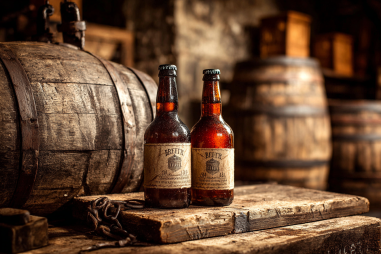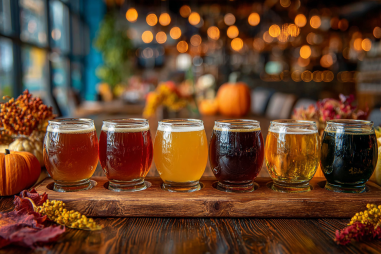When it comes to enjoying craft beers, understanding tasting notes can significantly enhance your experience, especially with unique styles like wheatwine. Wheatwine beer is a rich, powerful ale that combines the depth of barleywine with the distinctive characteristics of wheat malt. For those new to tasting this robust brew, learning what to look for—from appearance to finish—can open up a whole new world of appreciation. This guide will walk you through the common wheatwine beer tasting notes, helping you recognize and savor the complexities this style has to offer.
Why Tasting Notes Matter
Whether you’re a casual beer drinker or an aspiring connoisseur, paying attention to tasting notes transforms drinking from a simple act to a sensory journey. Tasting notes help you articulate what you’re experiencing, making it easier to compare different beers and discover your preferences. With wheatwine—a style known for its strong alcohol content and layered flavors—being able to identify the subtle and bold characteristics heightens your enjoyment and understanding. Keeping track of your impressions also aids in learning more about brewing techniques and ingredient influences, deepening your connection to the beer world.
Appearance: What to Observe
The first sensory encounter with wheatwine is sight. When pouring wheatwine into your glass, take a moment to observe its appearance. Typically, wheatwine exhibits a deep amber to mahogany hue, sometimes with ruby highlights depending on the specific malt bill. The beer often has a slightly hazy quality due to the high wheat content, which may contribute to a cloudier look compared to clearer barleywines.
Look at the head as well—wheatwines usually develop a creamy, off-white to tan foam that lingers for a reasonable amount of time. The size and retention of the head can indicate the malt profile and carbonation level. Swirling the beer gently can help you notice the “legs” or the tears running down the glass, which often hint at the alcohol content and body thickness.
Aroma: Wheat, Malt, Hops, and Yeast Traits
Aroma is one of the most exciting parts of tasting wheatwine as it sets the tone for the flavors to come. The wheat malt often imparts a distinctive bready, slightly dough-like scent that differentiates wheatwine from standard barleywine. This bready note can sometimes be reminiscent of freshly baked bread or cereal grain.
The malt backbone usually shines through with rich caramel, toffee, and sometimes even dark fruit aromas like raisin or plum. These sweet notes balance the wheat’s lighter aroma and contribute to the beer’s overall complexity. Because wheatwines can be quite malty, expect a rounded, almost dessert-like nose.
Hop aromas in wheatwine tend to be moderate to subtle but still play an important role. Depending on the brewery and recipe, you might detect floral, spicy, or earthy hop notes that provide contrast to the sweet maltiness. Yeast character also contributes, often bringing subtle fruity esters or even hints of clove or spice, especially if an ale yeast strain is used.
Taste: Sweetness, Bitterness, Alcohol Warmth
The flavor profile of wheatwine is multifaceted. At first sip, a newcomer might notice the pronounced sweetness that comes from the malt sugars. This sweetness echoes the caramel and toffee aromas while introducing rich, biscuity flavors courtesy of the wheat.
Balancing the sweetness, bitterness from hops makes its presence known, although it usually remains moderate. The hop bitterness prevents the beer from becoming cloying and adds depth to the flavor experience. Common hop flavors can range from slightly floral and citrusy to earthy or piney, again depending on the recipe.
One of the signature aspects of wheatwine tasting is the sensation of alcohol warmth. With alcohol by volume (ABV) frequently hovering between 8% and 12%, wheatwines deliver a noticeable but smooth boozy heat that complements the malt sweetness. This warmth can linger on the palate, adding to the beer’s robust character without overshadowing other flavors.
Mouthfeel and Finish Characteristics
When it comes to mouthfeel, wheatwines typically offer a full-bodied, smooth texture. The wheat malt lends a creamy, almost silky sensation that distinguishes wheatwine from more aggressively hopped or carbonated styles. The carbonation is generally moderate, enough to lift the flavors without making the beer feel heavy or overly fizzy.
The finish of a wheatwine tends to be long and warming. After swallowing, you might notice the residual sweetness lingering alongside a gentle bitterness and that characteristic alcohol warmth. Some wheatwines finish slightly dry, which can encourage another sip, while others keep a soft, sweet tail that feels like dessert.
Variations Depending on Brewery and Recipe
Like any craft beer style, wheatwine’s tasting notes can vary significantly based on the brewery’s approach and the recipe used. Some breweries emphasize the wheat’s bright, bready traits more heavily, creating a lighter and slightly more refreshing version of wheatwine. Others might boost the malt complexity and alcohol content for a richer, more intense experience.
Hop profiles vary as well—some wheatwines lean heavily into American hop varieties, offering citrus and pine notes, while others stick with traditional English or German hops, providing earthier or spicier flavors. Additionally, yeast strains and fermentation techniques can influence the presence of fruity or spicy esters, adding unique dimensions to each batch.
Limited editions or barrel-aged wheatwines can introduce even more complexity, from oak and vanilla notes to subtle smokiness or added sweetness from the aging process. Exploring different versions helps develop a nuanced understanding of the style’s possibilities.
Tips for Recording Your Own Tasting Notes
One of the best ways to deepen your appreciation of wheatwine is to develop the habit of writing down your own tasting notes. Here are some tips to make this practice enjoyable and insightful:
- Start simple: Focus on the main categories: appearance, aroma, taste, mouthfeel, and finish. This keeps your notes organized.
- Use descriptive words: Try to be specific—rather than just “good,” note “caramel sweetness” or “spicy hop aroma.” The more precise, the better.
- Compare and contrast: Taste multiple wheatwines side-by-side or in succession and jot down differences. This sharpens your sensory skills.
- Be honest: Write what you truly perceive, not what you think you should taste. Individual interpretations vary.
- Keep it handy: Use a small notebook, a beer tasting app, or voice memos to capture impressions on the spot.
Enhancing Your Wheatwine Tasting Experience
Understanding and recognizing wheatwine beer tasting notes enriches every sip. The interplay of wheat’s bready aroma, the malt’s caramel sweetness, moderate hops, and the smooth alcohol warmth creates a layered experience that rewards attention and curiosity. Take your time with each pour, allowing the beer to warm slightly to unlock more aromatic and flavor complexity. Use the knowledge from your tasting notes to explore different brands and styles within the wheatwine category, and don’t be afraid to revisit a favorite after some time to discover new nuances.
By paying attention to appearance, aroma, taste, mouthfeel, and variations, you’re not just drinking beer—you’re engaging with craft and tradition. Enjoy the journey that wheatwine offers and savor each rich, robust moment.







